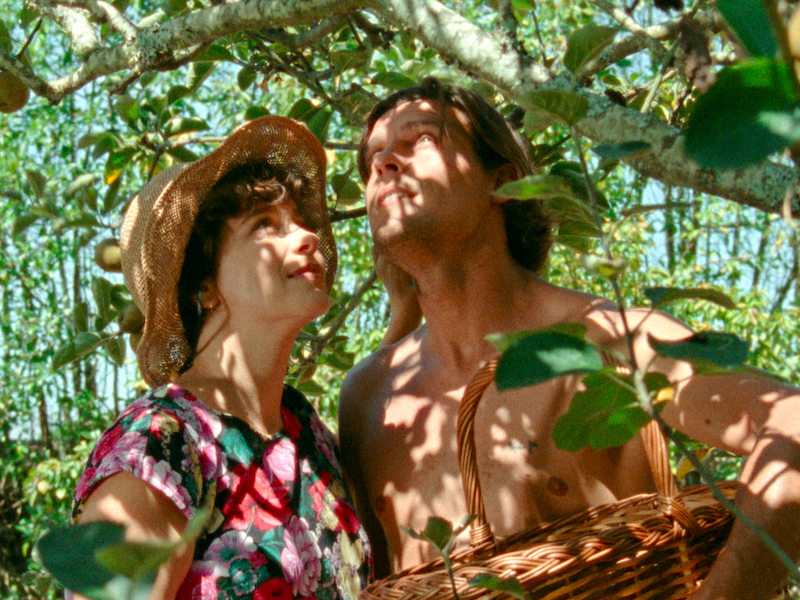
Faced with the cancellation of their normal plans due to the covid pandemic, filmmakers Maureen Fazendeiro and Miguel Gomes decide to go into lockdown with some longtime friends and collaborators instead to make a film in a more isolated place.
Pedro Emilio Segura Bernal: [...] This year we have seen many pandemic films, but not as many as I had expected. We could say that, in a way, this film may fit the label, whatever that means. But it’s not a record of the pandemic lockdown, like, I don’t know, a diary-film shot on a cellphone, talking about how everything’s so hard… It’s all the contrary: this was shot on 16mm, in a collective effort–a joyful spectacle. I feel like it’s an attempt to recover something that got lost in those months. For example, a kiss, something so basic, becomes the riskiest or most punk act imaginable.
Maureen Fazendeiro: Yes, when we were thinking about the film, one of the first things that we did was to read about the new rules imposed on film shoots. We began with this while everything was on pause, thinking about the possible film. And the kiss, as you mentioned, was one of the things that we were forbidden to shoot. So we had to create new rules to be able to shoot this, to shoot the impossible. When we went to the house, in the beginning, we didn’t have anything, we didn’t have an argument, nor a script, but we had three ideas. The first one: we wanted to shoot a kiss. And to be able to shoot a kiss, it had to be the last thing during the shooting. But we wanted to begin the film with it. So, that’s where the inverted chronology of the film comes from. Another idea was to shoot a construction. And that ended up being a deconstruction, due to the inverted time. The last idea was to make a film that worked with real life, with whatever happened to us in the house in our daily lives. The first time we met at the place, before the 40 days of the shooting, there was this apple next to the door. A month later, when we went to the house for a few days to think about the film, we saw the apple there but it was completely rotten.
Maureen Fazendeiro and Miguel Gomes in conversation with Pedro Emilio Segura Bernal1
“The Tsugua Diaries harkens back to Renoir père as well as Matisse’s spirited, lovely Travail et joie painting from his Nice series: art-making as play, celebrating the joy of being alive. Children know this instinctively, and adults forget it. The Tsugua Diaries is a project intended to return serious adult cinemagoers to this childlike state of mind, or least the one where work and pleasure blend together in one. All of this could only end (and begin) this way: with dancing, bottles of beer, smokes, and ‘The Night.’ For this viewer, these images of nocturnal dancing are already becoming the iconic ones of the pandemic: silhouetted bodies in motion, resisting entropy and a destructive virus, fighting back the only way they know how. Working it, with joy.”
Robert Koehler2
“All this meta-waggishness is very self-satisfied, to be sure. And yet, through the thick blanket of irony gradually emerges genuine feeling, and the inverted chronology builds to a celebration of community that is heartfelt and poignant after the experience of the last year and a half. The film is bookended by party scenes, both shot from the same vantage and both scored to ‘The Night’ by Frankie Valli and the Four Seasons. In the first, Crista, João and Carloto are dancing in the empty living room; in the second, the space is teeming with jubilant bodies. Only one of them triggers intense longing.”
Giovanni Marchini Camia3
- 1Pedro Emilio Segura Bernal, “The Possible Cinema: A Conversation with Maureen Fazendeiro and Miguel Gomes,” Mubi Notebook, 24 September 2021.
- 2Robert Koehler, “The Tsugua Diaries (Maureen Fazendeiro & Miguel Gomes, Portugal),” Cinema Scope Online, 11 September 2021.
- 3Giovanni Marchini Camia, “The Tsugua Diaries delights with a playful Portuguese puzzle,” Sight and Sound, 13 July 2021.

